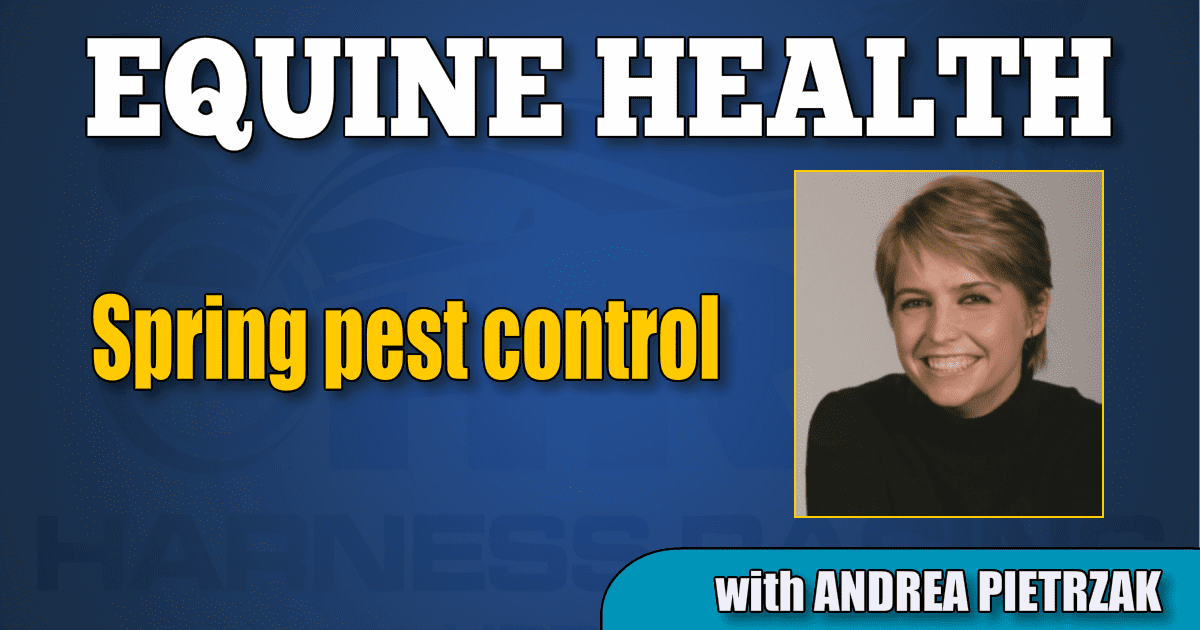Spring pest control
Spring is that all-too-brief transition from the chill of sub-zero morning jogs to the headaches of hot-weather racing. As the temperature begins to slowly climb, topping the spring to-do list should be tackling “overwintering” parasites around the barn, and a seasonal herd deworming.
by Andrea Pietrzak
Spring is a great time to tackle overwintering pests before they start multiplying. This includes wasps, bees and flies. Most of these nuisance insects survive the winter by burrowing into cracks and crevices in south- or west-facing walls, in gaps around windows and in food storage areas. Dormant during the winter, as soon as the sunlight hits, these bugs begin to build nests and lay eggs.
Ideally, spring building maintenance should include sealing large gaps and cracks in south- or west-facing walls, repairing broken screens or windows, and cleaning any eavestroughs and downspouts. Trees and shrubs that touch barns or buildings can be trimmed back and garden-centre insecticides like Wilson’s, Raid or Ortho, can be applied around the foundation of south and west walls.
For those who prefer to use non-poisonous methods as pest control, spring is an important time. Fly parasites, such as stingless, nocturnal wasps need to be ordered, shipped and ready for use by the long weekend in May and bat houses need to be in place by early April. In some areas of the country, agencies and birding groups will help create habitats for insect-eating birds, such as barn swallows and Purple Martins, and install owl boxes in barns.
Mosquitos
It is wishful thinking that mosquitos die off during cold winter months. Mosquitoes have been around since the dinosaurs and the only two places on the planet without mosquitoes are Iceland and Antarctica.
The females of many mosquito species can survive winter in a state known as diapause for more than six months regardless of how low the temperature gets. Some species lay eggs in the soil, while others produce larva that can “hibernate” in a few millimetres of moisture under layers of ice. This means that all it takes for the biters to come back is a bright, sunny day.
The condensation around window ledges, leaky pipes or faucets are perfect for producing mosquitoes, as are dead plants and leaves, and manure pits or piles. Any area that collects melting snow or pools of standing water – like outdoor water buckets, old tires and tarps or coverings – should be empty or disinfected.
Mosquito larvacides are usually applied to large, stagnant bodies of water like drainage ditches, marshlands, wetlands and swamps throughout the month of April. However, most municipalities require both chemical and non-chemical larvacides be applied by licensed, commercial pest management companies only.
Adulticides tend to be used in buildings, on pasturelands and lawns from May until the first killing frost of the fall. Most do provinces permit rural landowners and farmers to use adulticides labeled for domestic use from a ready-to-use aerosol, fogger or tank sprayer on their property without a licence.
And remember, yellow incandescent lights or fluorescent lights are less attractive to mosquitoes than compact fluorescent bulbs (CFLs) and regular LEDs.
Deworming
Deworming horses used to be done at regular intervals throughout the year to combat common internal parasites like large and small strongyles (Redworms and Bloodworms), ascarids (Round Worms), pinworms and bots. Unfortunately, research has shown that blanket parasite control strategies have led to widespread drug resistance in many parasite populations.
Horse owners were then told to follow a rotating deworming program that switches between three drug classes to fight parasites – benzimidazoles (e.g., fenbendazole and oxibendazole), pyrimidines (pyrantel salts such as pyrantel pamoate and pyrantel tartrate), and macrocyclic lactones (e.g., ivermectin and moxidectin by themselves or combined with praziquantel).
However, recent studies published in and after 2014 have discovered that in some geographic areas moxidectin and ivermectin only suppress strongyle egg production for a period of three to five weeks before parasite infection rebounds to pre-treatment levels. Typically, egg reappearance used to take three months for moxidectin and six to eight weeks for ivermectin.
As a result, the American Association of Equine Practitioners (AAEP) advocates for fecal sampling prior to deciding the best time to deworm and with what medication. Not only does fecal sampling calculate the number of parasite eggs present but can also help identify which parasite species are present in the largest numbers.
If feasible, a second fecal egg count can be performed 10 to 14 days after deworming. This fecal egg count reduction test can identify if a deworming dose has been effective, if another dose is needed or if a different deworming medication is required.
Most healthy adult horses are low to medium shedders passing somewhere in the range of 200 to 500 parasite eggs per gram of feces, whereas high shedders can pass 500 or more eggs per gram. It is important to know which horses are high, or low, shedders since 20 per cent of any given horse population is responsible for 80 per cent of all parasite eggs on a particular property. Chronic shedders may need more frequent deworming than other horses.
Typically, spring-time fecal samples collected horses in Canada contain strongyles, ascarids and sometimes tapeworm at relatively low levels, but deworming is recommended regardless to minimize pasture infestation and to ensure horses returning to work experience optimal nutritional uptake.
Horses that have overwintered in the Gulf region of the United States tend to have higher levels of bot eggs and, depending on how damp and low-lying the pasture land, can have fluke worms. Fluke worms are also more prevalent in Great Lakes-area pastures that are prone to temporary Spring-time runoff.
Spring-time deworming is especially important for nursery farms where young foals will be grazing along side a herd of mares.

















